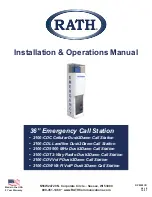
7-7
Cisco Unified SIP Phone 3911 Administration Guide for Cisco Unified Communications Manager
OL-14029-01
Chapter 7 Troubleshooting and Maintenance
Resolving Startup Problems
Step 2
Choose
Delete
to remove the phone from the Cisco Unified Communications
Manager database.
Step 3
Add the phone back to the Cisco Unified Communications Manager database. See
the
“Adding Phones to the Cisco Unified Communications Manager Database”
section on page 2-9
for details.
Step 4
Power cycle the phone:
•
If the phone receives power from an external power source, unplug the
Ethernet cable from the Network port on the phone, then unplug the power
supply from the DC adaptor port on the phone. Next, reconnect the power
supply and then reconnect the Ethernet cables.
Caution
Always unplug the upstream Ethernet cable from the phone before unplugging the
power supply. Unplugging the power supply before unplugging the upstream
Ethernet cable could result in a service interruption on the network.
•
If the phone receives inline power, unplug the cable from the Network port on
the phone and then plug it back in.
Note
•
When you remove a phone from the Cisco Unified Communications Manager
database, its configuration file is deleted from the Cisco Unified
Communications Manager TFTP server. The phone’s directory number or
numbers remain in the Cisco Unified Communications Manager database.
They are called “unassigned DNs” and can be used for other devices. If
unassigned DNs are not used by other devices, delete them from the Cisco
Unified Communications Manager database. You can use the Route Plan
Report to view and delete unassigned reference numbers. Refer to
Cisco
Unified Communications ManagerAdministration Guide
for more
information.
•
Changing the buttons on a phone button template, or assigning a different
phone button template to a phone, may result in directory numbers that are no
longer accessible from the phone. The directory numbers are still assigned to
Содержание 3911
Страница 4: ......
















































